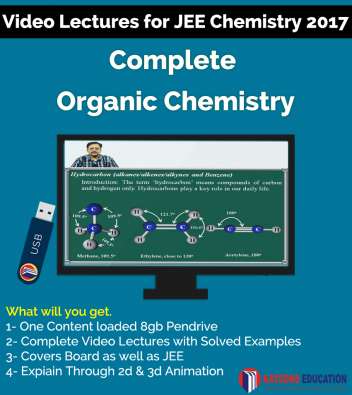Displaying 1-3 of 3 result(s).
About Course
-
1. One 8 GB pendrive / Micro SD Card Contenting video lectures
2. 42 hours of video lectures
3. covering 11th and 12th syllabus as well as JEE
4. Dr. Joseph Daniel ( Ph.D IIT Kanpur Experience: 15 Years)
5. Mr. Sudhi Raj Verma (B.Tech from IIT Kanpur and M.Tech From IIT Bombay Experience: 18 years )
Valid till 30th June 2017
Topics covered in this course
-
Basic Organic Chemistry
Day 1: Introduction To Organic Chemistry, Acyclic or open chain compounds, Modern Definition of Organic Chemistry, Reasons for Large Number of Organic Compounds, Condensed and Bond-line Structural Formulas, Classification of Organic Compounds, Alicyclic or Closed Chain or Ring Compounds, Heterocyclic, Aromatic compounds, Benzenoid aromatic compounds, Homologous Series,
Day 2: Nomenclature, Root ward, Primary suffix, Secondary Suffix, Primary Prefix, Secondary prefix, Nomenclature Rules – Saturated and Branched Chain, Unsaturated and Functional Groups,
Day 3: Cyclic Compounds, Aromatic Compounds are Cyclic,
Day 4: Isomerism, Structural Isomerism, Chain Isomerism, Functional Isomerism, Positional Isomers, Metamers, Tautomerism,
Day 5: Stereo Isomerism, Wedge and Dash, Fisher Projection, Sawhorse projections, Newman Projections, Conformers of Butane C4H10, Cyclo Hexane, Geometrical Isomerism.
Day 6: Optical Isomerism, Discovery of Optical Isomerism, Measuring Optical Activity, Number of Optical Isomers of an Compound, Importance of Optical Compounds in Biochemistry, Nomenclature of Geometric Isomers (E and Z) in Case More Than Two Different Groups are Present and Optical Isomers (R and S), Isotopes, Double and Triple Bonds, Double bonds: E/Z, Chiral Carbons:- R/S, Assigning Stereocentres Using Fischer Projections,
Day 7: Purification and Elemental Analysis Methods of Purification of Organic Compounds, Sublimation, Crystallisation, Distillation, Fractional Distillation, Distillation Under Reduced Pressure, Steam Distillation, Differential Extraction, Chromatography, Qualitative Analysis of Organic Compounds, Detection of Carbon and Hydrogen, Detection of other Elements, Test for Nitrogen, Quantitative Analysis, Carbon and Hydrogen,
Day 8: Nitrogen, Halogens Carius Method, Sulphur, Phosphorus, Oxygen, Empirical Formula and Molecular Formula, Determination of Molecular Mass, Duma’s Method, Chemical Method,
Day 9: Illustration.
Reaction Mechanism
Day 1: Reaction Mechanism, Introduction, Carbocations, Carbanions, Nucleophiles and Electrophiles, Electron Displacement in Substance, Strength of Various Atom and Groups, Resonance.
Day 2: Conditions For Resonance, Resonance Effect or Mesomeric Effect, Hyperconjugation, Electromeric Effect (E-Effect), Classification of Reactions, Strength of Acid (in General org. chemistry),
Day 3: Reaction Mechanism of Different Types, Electrophilic Addition Reactions, Addition of HX to Alkene, Markownikoff’s Rule, Nucleophilic Addition Reaction, Stereochemistry of Addition Nucleophillic, Anti-Markownikoff’s Rule (Kharash Peroxide Effect), Chain-Initiating Step, Chain-Propagation Step, Chain-terminating Step, Free Radical Addition Reaction.( Is Shown Only By Hbr), Substitution Reactions,
Day 4: Free Radical Reactions in Cyclic Compounds, Stereochemistry of Radical Substitution Reaction, Electrophilic Substitution Reaction (SE), Substitution Electrophillic and Addition Electrophillic, Nucleophilic Substitution Reactions, SN1 Reaction, SN2 Reaction,
Day 5: Elimination Reactions, E1 (Elimination) Reaction, E1-CB (Elimination) Reaction, E2 (Elimination) Reaction,
Day 6: Illustration.
DVD 2
Hydrocarbon
Day 1: Hydrocarbon (Alkanes/Alkanes/Alkanes) Introduction, Classification, Physical Properties, Alkanes Preparation Natural Source – Petroleum & Natural Gas, General Oxidation/Reduction,
Day 2: Chemical Properties, In case of Bromination, Oxidation, Decomposition, Isomerization, Aromatisation, Reaction With Steam, Alkenes, Isomers, Physical State, Preparation of Alkenes Dehydrohalogenation of Alkyl Halides, Hindered Base Given Hoffman Product as Major Isomers, Dehydration of Alcohols, Dehalogenation, Reduction of Alkynes,
Day 3: Chemical Properties of Alkenes Addition of Hydrogen, Addition of Halogens, Addition of Halogen Acid/Hydrogen Halide, Addition of Water (H2O) (Hydration), Hydroxylation (Glycol Formation), Ozonolysis,
Day 4: Alkynes, Alkynes, Chemical Properties pf Alkynes, Aromatic Hydrocarbon, Structure of Benzene, Complete Delocalization, Properties of Benzene, Dipole Moment, Electrophilic (Aromatic) Substitution Reactions,
Day 5: Illustration.
Halogen Compounds
Day 1: Introduction, Classification, Nomenclature. Day 2: Chemical Properties, Elimination, C – (I) → Sub Nucleophillic, Electron with Drawing Group, Day 3: Illustration. Alcohols, Phenols and Ethers Day 1: Alcohols, Phenols and Ethers, Mono, Di, tri or Polyhydric Compounds, Allylic Alcohols, Ethers, Nomenclature, Preparation of Alcohol (A) Hydration of Alkenes, Reduction by catalytic Hydrogen, Hydrolysis of Esters, From Acid and Acid Derivatives.
Day 2: Chemical Properties, Distinguish between 1° 2° and 3° Alcohols, Williamson Ether Synthesis, Oxymercuration/Demercuration in Presence of Alcohol, Auto Oxidation,
Day 3: Phenol Preparation, Physical Properties, Chemical Properties.
Day 4: Illustration.
Ketones and Aldehydes
Day 1: Ketones and AldehydesCarbonyl Compounds, Structure of the Carbonyl Group, Nomenclature of ketones and Aldehydes,
Day 2: Preparation of Aldehyde and Ketone, Hydroboration Oxidation, Decarboxylation of Calcium Salts of Carboxylic Acids, OXO Process, Wacker Process, Qzonolysis, Chemical Properties, Reduction of Carbonyls,
Day 3: Addition Reaction (Nucleophillic), Cannizzaro Reaction, Aldol Condensation, Crossed Aldol Condensation, Claisen Condensation, Aromatic Aldehyde and Ketone, Chemical Properties, Claisen Schmitt Condensation, Knoevenagel Cond, Reformatsky Reaction,
Day 4: Illustration.
DVD 3
Carboxylic Acid
Day 1: Introduction, Classification, Nomenclature, IUPAC Names, Nomenclature of Dicarboxylic Acids, IUPAC Names of Dicaroboxylic Acids, Structure and Physical Properties of Carboxylic Acids, Acidity of Carboxylic Acids Measurement of Acidity,
Day 2: Common Reducing Agents and Their Reactions, Some Common Reactions of Acid salts, Carboxylic Acid Derivatives Introduction, Structure and Nomenclature of Acid Derivatives Ester of Carboxylic Acids, Amides, Nitriles, Hydrolysis to an Acid, Synthesis from an Acid, Acids Halides, Acid Anhydrides, Boiling Points and Melting Points, Physical Properties, Chemical Properties.
Day 3: Illustration.
Nitrogen Compounds
Day 1: Nitrogen Compounds, UREA, Preparation, Properties Physical, Chemical, Amines Introduction, Classification, Nomenclature, Preparation Primary Amines, Secondary Amines, Tertiary Amine, Hoffman’s Method, Physical Properties, Chemical Property, Aromatic Amine, Used in Separation of Amines, Reactions given only by 10 Amine, Reactions shown only by 20 Amines, Reactions Shown Only by 3o Amines,
Day 2: Aniline Preparation, Chemical Properties, Substitution Electrophilic, Benzene Diazonium Chloride-Reaction of Diazanium Salt, Cyanides and Isocyanides, Isocyanides Preparation, Nitro Compounds, Halogenation,
Day 3: Illustration.
Biomolecules
Day 1: Introduction, Classification of Carbohydrates, Another Classification, Glucose, Fructose, Glycosidic Linkage, Disaccharides, Polysaccharides, Proteins, Amino Acids, Isoelectric Point, Structure of Proteins, Classification of Proteins, Denaturation of Proteins, Enzymes, Vitamins, Nucleic Acids, Basic Structure of Nucleic Acid, H-bonds between the nitrogenous bases in DNA, Different Types of RNA Formed in the Cell, H-bonds between the nitrogenous bases in RNA, Replication of two DNA.
Day 2: Illustration.
Polymers
Day 1: Introduction, Classification of Polymers,
Day 1: Illustration.
Chemistry in Everyday Life
Day 1: Introduction, Drugs, Different Medicines Antacids, Antihistamines, Neurologically Active Drugs, Antimicrobials, Chemicals in Food, Cleaning Agents,
Day 1: Illustration.
Complete Product Details
-
Subject : Chemistry for jee mains and advance
Class : 11th and 12th
Course Doration : 28 Hours
Validity : 17-Jun
Chapters : Organic chemistry Classification and representation of organic molecules, Nomenclature of organic molecules, Determination of, molecular formula, General concepts of chemical bonding, Hybrid orbital’s and geometry of molecules, Bonding weaker than covalent bonding, Factors affecting the nature of covalent bonding, Aromaticity 1 (aromaticity of annulenes), Aromaticity 2 (aromaticity of other compounds), Isomerism (constitutional), Basic Organic Chemistry, Reaction Mechanism, Hydrocarbon, Halogen Compounds, Alcohols, Phenols, Ethers, Ketones and Aldehydes, Carboxylic Acid, Nitrogen
9174017918
|


